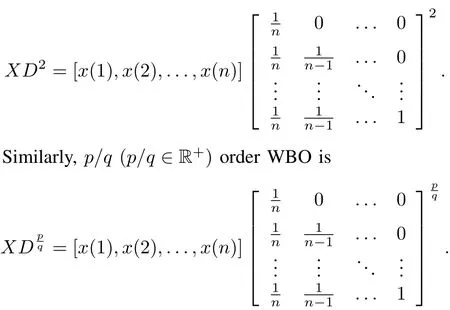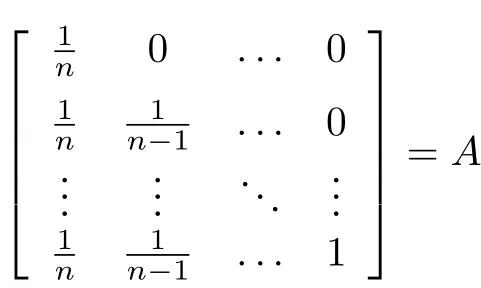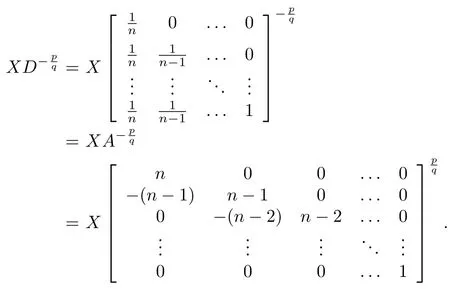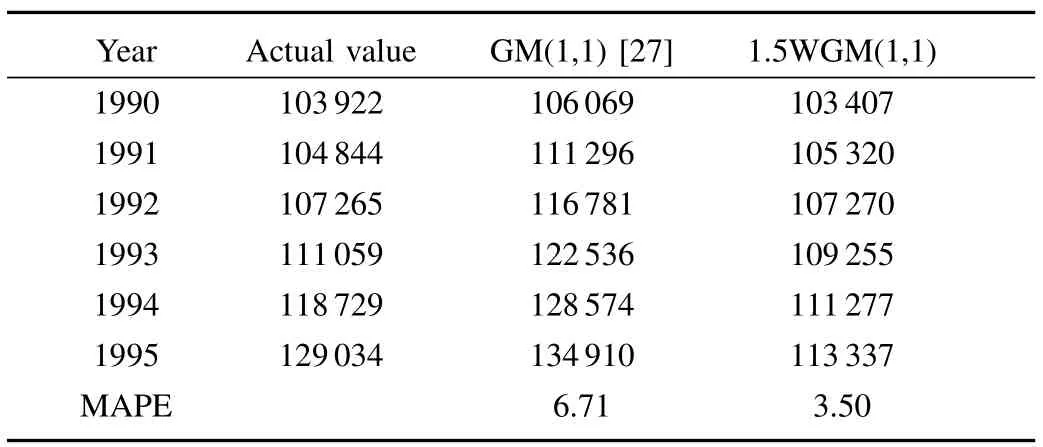Using the Fractional Order Method to Generalize Strengthening Buffer Operator and Weakening Buffer Operator
2018-12-24LifengWuSifengLiuSeniorMemberIEEEandYingjieYangSeniorMemberIEEE
Lifeng Wu,Sifeng Liu,Senior Member,IEEE,and Yingjie Yang,Senior Member,IEEE
Abstract—To reveal the relationship between a weakening buffer operator and strengthening buffer operator,the traditional integer order buffer operator is extended to one that is fractional order.Fractional order buffer operator not only can generalize the weakening buffer operator and the strengthening buffer operator,but also results in small adjustments of the buffer effect.The effectiveness of the grey model(GM(1,1))with the fractional order buffer operator is validated by six cases.
I.INTRODUCTION
DUE to growing demand for reliable small sample statistics,small sample prediction is a topic of great importance topic.Over the years,many scholars have carried out a variety of research[1]-[4].Among these papers,it is reported that the forecasting performance of the grey model is better than many conventional methods with incomplete or insufficient data[4]-[6].Grey system theory was developed by Deng[7].As the primary forecasting method of grey system theory,GM(1,1)has been applied in many fields[4]-[7].However,GM(1,1)is suitable for a stable time series,but predicting a non-stationary series is a difficult problem which deserves to be researched.
For a non-stationary time series prediction problem,the theory on how to select a model would lose its validity.That is the problem is not that of selecting a better model;instead,what needs to be considered is that when a system is severely affected by shock,the available data of the past cannot truthfully reflect the law of the system.Under such circumstances,the buffer operator of grey system theory[7]has been successfully used in many fields to overcome the above difficulties[8]-[13],and it combines quantitative and judgmental forecast(qualitative analysis).Many kinds of buffer operators have been proposed simultaneously[14]-[18],and the process to choose a suitable buffer operator is very important in practice.In this paper,many kinds of buffer operators are unified and generalized based on the fractional order method.
The rest of this paper is organized as follows.Section II is a compendium of the grey buffer operator.In Section III,the inherent relationship between a weakening buffer operator and strengthening buffer operator based on fractional order method is revealed.In Section IV,real examples for a fractional order buffer operator are discussed.Some conclusions of this study are provided in the final section.
II.WEAKENINGBUFFEROPERATOR AND STRENGTHENINGBUFFEROPERATOR
Assume that X={x(1),x(2),...,x(n)}is the true behavior sequence of a system,and the observed behavior sequence of the system is Y={x(1)+ є1,x(2)+ є2,...,x(n)+ єn},where(є1,є2,...,єn)is a term for the shocking disturbance.To correctly discover and recognize the true behavior sequence X of the system from the shock-disturbed sequence Y,onefirst has to go over the hurdle(є1,є2,...,єn)(that is to say cleaning up the disturbance).If we directly use the severely impacted data Y to construct the model and make predictions,then our prediction is likely to fail,because what the model described was not the true situation X of the underlying system.
The wide existence of severely shocked systems often causes quantitative predictions that disagree with the outcomes of intuitive qualitative analysis.Hence,seeking an equilibrium between qualitative analysis and quantitative predictions by eliminating these disturbances is an important task in order to discover the true situation of the system.The grey buffer operator proposed by Liu can address the problem,and its definition is as follows.
Definition 1[7]:Assume that raw data sequence is X={x(1),x(2),...,x(n)}.If∀k=2,3,...,n,x(k)-x(k-1)>0,then X is called a monotonic increasing sequence.If∀k=2,3,...,n,x(k)-x(k-1)<0,then X is called a monotonic decreasing sequence.If there are k,k′∈ {k=2,3,...,n}such that x(k)-x(k-1)> 0,x(k′)-x(k′-1)< 0,then X is defined as a random vibrating or fluctuating sequence.If M=max{x(k)|k=1,2,...,n}and m=min{x(k)|k=1,2,...,n},then M-m is called as the amplitude of the sequence X.
Lemma 1[7]:X={x(1),x(2),...,x(n)}is a monotonic increasing sequence.Then,XD={x(1)d,x(2)d,...,x(n)d}is a weakening buffer operator(WBO),iff x(k)d≥x(k),k= 1,2,...,n;XD = {x(1)d,x(2)d,...,x(n)d}is a strengthening buffer operator(SBO),iff x(k)d≤x(k),k=1,2,...,n.
Lemma 2[7]:Assume that X={x(1),x(2),...,x(n)}is a monotonic decreasing sequence.Then,XD={x(1)d,x(2)d,...,x(n)d}is a WBO,iff x(k)d≤x(k),k=1,2,...,n;XD={x(1)d,x(2)d,...,x(n)d}is a SBO,iff x(k)d≥x(k),k=1,2,...,n.
Lemma 3[7]:Assume that X={x(1),x(2),...,x(n)}is a fluctuating sequence,XD={x(1)d,x(2)d,...,x(n)d}is a WBO,iff max{x(k)|k=1,2,...,n}≥max{x(k)d|k=1,2,...,n}and min{x(k)|k=1,2,...,n}≤min{x(k)d|k=1,2,...,n};XD={x(1)d,x(2)d,...,x(n)d}is a SBO,iff max{x(k)|k=1,2,...,n}≤max{x(k)d|k=1,2,...,n}and min{x(k)|k=1,2,...,n}≥min{x(k)d|k=1,2,...,n}.
Definition 2[7]:Assume that raw data sequence is X={x(1),x(2),...,x(n)},XD={x(1)d,x(2)d,...,x(n)d},where

D is a first order WBO whether X is monotonic decreasing,increasing,or vibrating.If XD2=XDD ={x(1)dd,x(2)dd,...,x(n)dd},D2is a second order WBO.Similarity,D3is a third order WBO.
If

then D is a first order SBO when sequence X is either monotonic decreasing or increasing.If XD2=XDD={x(1)dd,x(2)dd,...,x(n)dd},D2is a second order SBO.Similarity,D3is a third order SBO.
x(0)(k)d=x(0)(k)of WBO is consistent with the results of above studies,which all suggested that more emphasis should be placed on the most recent and most relevant information.
III.THERELATIONSHIPBETWEENWBOANDSBO
Due to traditional weakening buffer operators cannot tune the effect intensity to a small extent,which leads to problems where the buffer effect may be too strong or too weak.Considering this situation,the fractional weakening buffer operator is constructed like in fractional-order systems[19]-[21].Equation(1)can be expressed by
The second order WBO can be expressed by

Theorem 1:For original data X=[x(1),x(2),...,x(n)],the-p/q(p/q∈R+)order WBO from(1)is the p/q order SBO.
Proof:Set

since-p/q(p/q∈R+)order WBO is

If sequence X =[x(1),x(2),...,x(n)]is a fluctuating sequence,x(l)= max{x(k)|k = 1,2,...,n},x(h)=min{x(k)|k=1,2,...,n},because[x(l),x(l),...,x(l)]≥[x(l),x(l),...,x(l)]and A is an invertible matrix,we have[x(l),x(l),...,x(l)]≥[x(l),x(l),...,x(l)]that is[x(l),x(l),...,x(l)]≥[x(l),x(l),...,x(l)];Similarly,we have[x(h),x(h),...,x(h)]≤ [x(h),x(h),...,x(h)].So the-p/q order WBO is the p/q order SBO when sequence X is a fluctuating sequence.
So the-p/q(p/q∈R+)order WBO from(1)is the p/q order SBO. ¥
Corollary 1:For original data X=[x(1),x(2),...,x(n)],the-p/q(p/q∈R+)order SBO from(2)is the p/q order WBO.
Corollary 2:For original data X=[x(1),x(2),...,x(n)],if nonnegative matrix B satisfiesandis SBO(WBO),thenis WBO(SBO).
The procedures of the GM(1,1)model with the p/q order WBO(p/q WGM(1,1))are more complex than the traditional GM(1,1),because more work must be done before forecasting.The procedures can be summarized as follows:
Step 1:Given a raw data sequence X(0)= {x(0)(1),x(0)(2),...,x(0)(n)},p/q order WBO sequence is
Step 3:The parameter a and b can be obtained by

where

Step 5:If the predicted value x(0)(n+1),x(0)(n+2),...is not consistent with the result of qualitative analysis,then change the order number p/q(If we want to pay more attention to the recent data,the order number p/q must be the larger one.If we want to pay more attention to the old data,the order number p/q must be the smaller one,because the strengthening buffer operator reflects the priority of old data[22]).
Step 6:Repeat Step 1-5 until the predicted values x(0)(n+1),x(0)(n+2),...are consistent with the result of qualitative analysis.
IV.EXPERIMENTATIONRESULTS
To test the proposed model,mean absolute percentage error(MAPE=is used to evaluate the precision.
Case 1:Energy consumption forecasting in China[23]
The data from 1998 to 2005(X(0)={13.22,13.38,13.86,14.32,15.18,17.50,20.32,22.47})are used to establish different GM(1,1)models with different WBO,and the data from 2006 to 2007 are used to determine the optimal order of WBO.The results are shown in Table I.

TABLE I THERESULTS OFDIFFERENTGREYMODELS
As can be seen from Table I,0.1WGM(1,1)is the best model among the above models using the sample data.So 0.1WGM(1,1)is used to predict the data from 2008 to 2009.The results are listed in Table II.As can be seen from Table II,0.1WGM(1,1)yielded the lowest MAPE in out-of-sample data.This implies that 0.1WGM(1,1)can improve prediction precision.

TABLE II THERESULTS OFTWOGREYMODELS
Case 2:Electricity consumption per capita forecasting in China[24]
The data from 2000 to 2005(X(0)={132.4,144.6,156.3,173.7,190.2,216.7})is used to obtain different GM(1,1)models with different WBO,and the data of 2006 is predicted by these models.The results are shown in Table III.

TABLE III THEFITTEDVALUES ANDMAPEOFDIFFERENTGREYMODELS
As can be seen from Table III,both WGM(1,1)models are better than the best result of[23].As a conclusion,fractional order WBO has a perfect forecasting capability.
Case 3:The qualified discharge rate of industrial wastewater forecasting in Jiangxi in China[17]
The data from 2000 to 2005(X(0)={68.63,75.9,77.59,83.06,88.66,92.13})are used to construct two GM(1,1)models with WBO,and the data from 2006 to 2007 are predicted by these models.The results are shown in Table IV.

TABLE IV THEFITTEDVALUES ANDMAPEOFTWOGREYMODELS

TABLE V THEFITTEDVALUES ANDMAPEOFFOURGREYMODELS
As can be seen from Table IV,the WGM(1,1)model is better than the best result of[17],so fractional order WBO can improve the prediction accuracy of the conventional GM(1,1)model.
Case 4:The electricity consumption forecasting in Vietnam[25]
The data from 2000 to 2003(X(0)={1927,2214,2586,2996},unit:KTOE)are used to construct four models with WBO,and the data from 2004 to 2007 are predicted by these models.The results are shown in Table V.
As can be seen from Table V,the WGM(1,1)model is better than the best result of[17],so the fractional order WBO can improve the prediction accuracy of the conventional GM(1,1)model.
Case 5:The logistics demand forecasting in Jiangsu[26]
The data from 2005 to 2008 are used to construct three grey models with WBO,and the data from 2009 are predicted by these models.The results are shown in Table VI.
As can be seen from Table VI,the WGM(1,1)model is better than the traditional grey model,so the fractional order WBO can improve the prediction accuracy of the conventional GM(1,1).

TABLE VI THEFITTEDVALUES ANDMAPEOFTHREEGREYMODELS
Case 6:The energy production forecasting in China[27]
The 1985-1989 data is used for model building,while the 1990-1995 data is used as an ex-post testing data set.The results given by the GM(1,1)model and 1.5WGM(1,1),as well as the observed values,are shown in Table VII.

TABLE VII THEFITTEDVALUES ANDMAPEOFTWOGREYMODELS
Table VII shows that the 1.5WGM(1,1)model is better for forecasting the energy production in China.The forecasted values are more precise than the GM(1,1)model for data sequences with large random fluctuations.
V.CONCLUSION
Let us now return to fractional calculus.Fractional calculus is a name for the theory of integrals and derivatives of arbitrary order,which unifies and generalizes the notions of an integerorder differential and integral.Similarly,fractional order WBO unifies and generalizes the notions of WBO and SBO.As can be seen from Tables II-VII,GM(1,1)with the fractional order buffer operator can predict the development trend of the system accurately.
Six real cases were seen to obtain good results,however,the order p/q may be not optimal.In this paper,the order p/q is chosen from computational experiments.In future studies,it is suggested that the particle swarm algorithm should be used to determine the optimal order.
杂志排行
IEEE/CAA Journal of Automatica Sinica的其它文章
- Granular Computing for Data Analytics:A Manifesto of Human-Centric Computing
- The Cubic Trigonometric Automatic Interpolation Spline
- Mathematical Study of A Memory Induced Biochemical System
- Predictive Tracking Control of Network-Based Agents With Communication Delays
- Necessary and Sufficient Conditions for Consensus in Third Order Multi-Agent Systems
- Self-Tuning Asynchronous Filter for Linear Gaussian System and Applications
